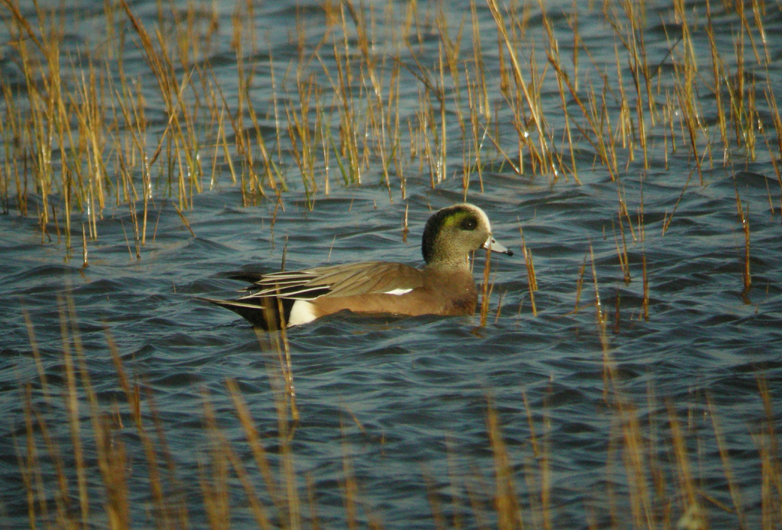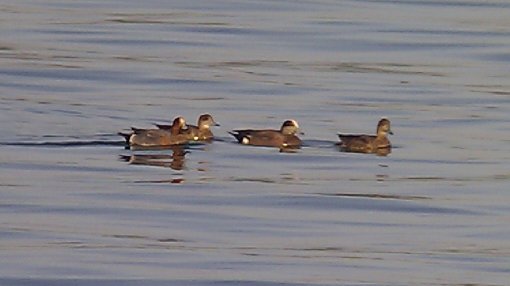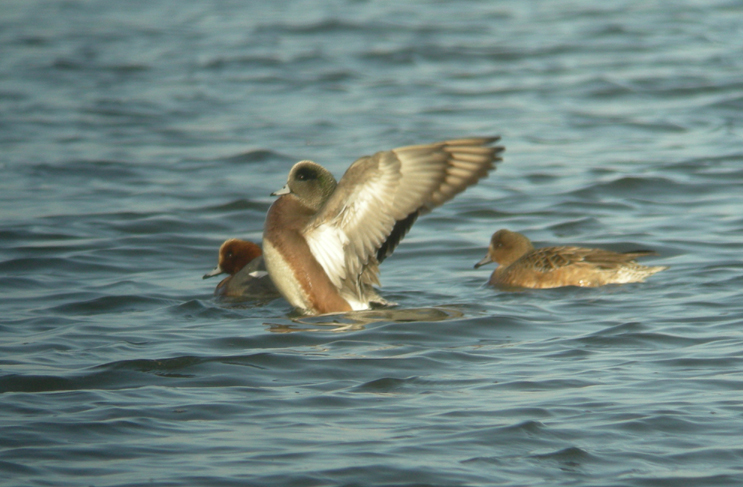American Wigeon
Anas americana
|
BOU Category:
Site status: Devon status: Conservation status: Conservation levels: |
AE (GB), A
(site)
† vagrant visitor very rare vagrant † BOCC3 (unlisted) †; SPEC (unlisted); IUCN European and Global (Least Concern) † n/a † |
International
A fluctuating, but long-term stable
population trend, it is presently estimated at 2.2 million mature
individuals†.
It breeds inland in low arctic and boreal regions, on lake islands
but sometimes far from water, in Alaska and across Canada as far N
as the Arctic Circle and in recent decades has spread E to Nova
Scotia. It reaches S to Nevada, Colorado and Nebraska, where
it is resident, and rarely also breeds in Michigan and Pennsylvania.
It winters on shallow sheltered inshore waters, estuaries and lakes,
generally S of its breeding range from 43°N; some along the Pacific
coast N to British Columbia, also inland where relatively less
common. It most commonly winters along the W Atlantic coast S from
Massachusetts, reaching the Gulf of Mexico and Caribbean Sea,
including the W Indies, S to Columbia††.
Following its post-breeding moult, migration from Sep peaks in Oct/Nov. Large numbers migrate E through the Great Lakes, then S along the Atlantic coast. The same route in reverse is taken in about Apr, reaching its furthest outposts in Alaska by late-May†.
Europe
Most frequently recorded in Britain and
Ireland, it is also recorded in (records to 1999 ~ 2001) in Iceland
(112), Finland (38), the Netherlands (35), France (31), Spain (18)
and at least seven other NW European countries†.
The establishment and increase of a population in NE Canada from the
1960s, reached by a NNE migration along the Atlantic coast in spring
could account for spring records in Greenland & Iceland†. Interestingly, nearly all Scandinavia records were also in spring,
but these may involve birds moving N that had crossed the Atlantic
in a previous autumn†.
Great Britain and Ireland
There were a total of 462 records for
Britain and Ireland up to the end of 2001 and 2000, respectively.
Only 22 records prior to 1958 and not annually recorded until 1973,
from then it has generally increased with double-figures of records
annually since the mid-1980s (except the early-1990s) with a peak of
30 in 2000. This species was no longer considered by BBRC from
2002†.
The vast majority of records are believed
to refer to genuine vagrants, but with records from every month of
the year, despite efforts to exclude them, accepted records could
still include some birds of captive origin†.
Direct evidence of genuine vagrancy shown by five ringed birds†, including a pullus ringed New Brunswick, E Canada on 06 Aug 1966,
shot on 07 Oct (2 months later) in Shetland, and a juv also ringed
there on 29 Aug 1968, shot on 12 Oct (6 weeks later) in Co. Kerry, in a flock of this species that peaked at 13 on the previous day†. Thought to be common in wildfowl collections, its free-flying
captive origin status is very poorly understood†.
Although records in all seasons are widespread, there exists bias to N & W regions in autumn; about a quarter of all records have occurred in Oct. Winter records are widespread, though generally occur where Wigeon winter, and spring records have a North Sea coast bias, suggestive of return migration†.
An increase in observer effort and an
eastward spread of the breeding population may account for the
increase in records in Britain. Population fluctuations and
improved identification proficiency apparently do not correlate to
record patterns.
Devon
Since the first two in 1983, there were
17 records of single birds, including those in 2011 and 2012. Three
of these records relate to single dates, other birds remained from
two days to some months. All have first dates within the
period 15 Sep - 07 Apr and nine appeared in Oct/ Nov†. The pattern of occurrence fits that for a transatlantic vagrant
that performs both autumn and spring migrations along the W Atlantic
seaboard and despite the presence of free-flying captive origin
birds in the country, there is a complete absence of any accepted
exotica (Cat D & E) records in Devon for this species (since the
inclusion of such records in DBRs from 1988). There is,
therefore, a presumption of genuine vagrancy, rather than of captive
origin, in Devon. All have appeared with Eurasian Wigeon
on reservoirs and on or next to tidal estuaries†.

15/01/2012 © Lee Collins
A hybrid drake on the Exe Estuary, off Exmouth, seen on 4 dates Oct - Dec 2007, was the first county record of an Eurasian Wigeon x American Wigeon†.
With hundreds of Eurasian Wigeon annually in N America, wild bred hybrids are regarded as more frequent than captive bred pairings. Hybrids, intraspecific variation and morphs are confusing identification pitfalls†.
Dawlish
Warren
| There are three records of single individuals: | |
|
27 Oct 1990 ~ 19 Jan 1991 07 Apr 2011 23 Oct 2011 - 11 Feb 2012 |
drake; found from the hide
(Brian Heasman et al) drake; close offshore (Alan Salter et al) drake; in Shutterton Creek (LC et al) |
All three records here relate to drakes
found with Eurasian Wigeon.
The first American Wigeon was found from
the hide amongst the assembled thousands of wildfowl on the estuary.
Owing to difficult viewing (no public access to the golf course) it
was not seen again until 13 Dec, and for a time moved to Exmouth,
last being seen on 19 Jan 1991. Only the 2nd record
for Devon; Britain recorded its then highest annual total in 1990.
The second record for the
recording area was found with three Wigeon offshore mid-afternoon,
where they remained until dark, but had departed by the following
morning. The latest Devon record and only the second to appear
in spring.

07/04/2011 © Ivan Lakin
The third drake first appeared with 1350+ Wigeon on the estuary along Shutterton Creek where it stayed, seen almost every day until 03 Feb 2012, when only relatively few wildfowl remained. It departed N at c.11:00 with a small flock of Wigeon and was later found on Bowling Green Marsh. Following a severe frost, it and hundreds of Wigeon returned to the less frozen waters of Shutterton Creek the following day, where it stayed until 11 Feb. It was relocated on 14 Feb at Powderham Marshes and soon settled on the adjacent Exminster Marshes, last seen there on 19 Mar 2012.

27/01/2012 © Lee Collins
Updated 30/08/2013
